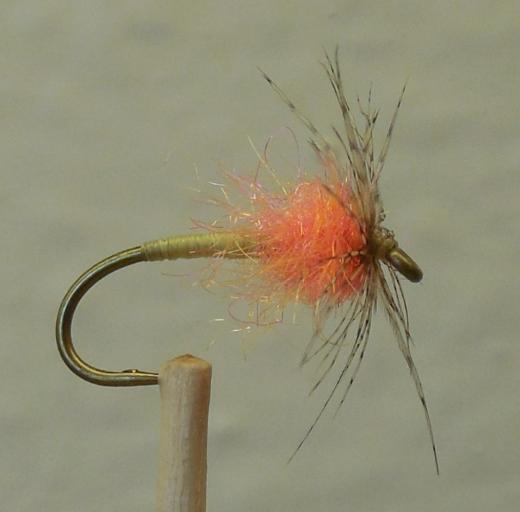Fly of the Month – Tup’s Indispensable
This month’s choice is a pure lark. I have never fished it, have tied only the example you see, and have little idea what it represents or what variety of trout might be favorably impressed or in what conditions. It caught my fancy, for reasons you’ll soon see, when I was reading Ian Whitelaw’s marvelous work, The History of Fly-Fishing in Fifty Flies. This book is a compendium of the history of significant developments in the sport (art?) over the centuries. According to the author, the precursor dry fly was developed by R.S. Austin in the late 1800s in England and then modified by the renowned G.E.M. Skues, the master of early nymph fishing, into the current design. What caught my attention was the history of the fly which led to its name. The author reports that “the mystery ingredient in the dubbing [for the thorax], it turned out, was hair from the scrotum of a ram, or tup. It was common practice at the time to tie an orange-dyed sponge or cloth to the belly of a ram so that the farmer could see by the presence of dye on a ewe’s back whether or not she had been ‘tupped’. This dye, possibly aided by a certain amount of urine, give the tup’s scrotal hair a particular hue, and the hair, after being thoroughly washed, apparently gave Austin’s fly that little something that trout found irresistible.”
Having encountered what I suspect is a more than temporary lack of availability of orange-tinted ram’s scrotal hair, I have substituted a more readily available material.
Even if I never use this fly, I enjoyed the read. But I suspect it will still catch fish.
Materials:
Hook: TMC 3761, #s 12-14
Thread: yellow or light cahill 8/0
Body: thread or yellow floss
Thorax: pink/orange seal
Wing: partridge or grouse hen hackle
1. Wind a slightly tapered body from the bend of the hook to about halfway to the eye.
2. Prepare a dubbing loop of seal hair, dub a heavy thorax, and trim to a roughly round shape, leaving some loose fibers sticking out.
3. Tie in a grouse or partridge feather and wind twice, tie off and trim.
4. Tie off the head, trim and add a drop of head cement.
Editor’s Note: According to Australian fly tyer/historian, Alan Shephard, “Using fur from the ram's testicle area wasn't even an original idea. The first use of this material goes to Alexander Mackintosh in the bookThe Driffield Angler, 1806. He suggests, ‘Take a little fine wool from the ram’s testicles, which is a beautiful dusty yellow.’"


